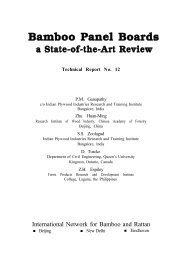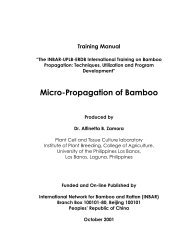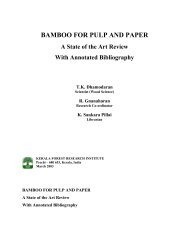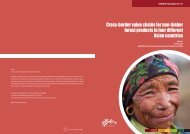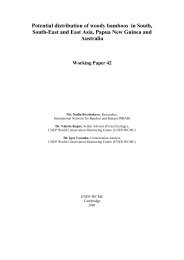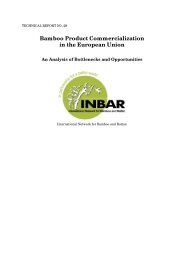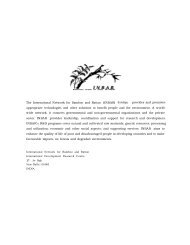The Bamboo and Rattan Sectors in Asia: an Analysis of ... - INBAR
The Bamboo and Rattan Sectors in Asia: an Analysis of ... - INBAR
The Bamboo and Rattan Sectors in Asia: an Analysis of ... - INBAR
You also want an ePaper? Increase the reach of your titles
YUMPU automatically turns print PDFs into web optimized ePapers that Google loves.
as <strong>in</strong>dustries develop, there is a tendency to <strong>in</strong>crease <strong>in</strong>vestments <strong>in</strong> technology, with<br />
<strong>in</strong>creas<strong>in</strong>g mech<strong>an</strong>ization, <strong><strong>an</strong>d</strong> <strong>in</strong> higher-skilled labor. <strong>The</strong>se issues are import<strong>an</strong>t <strong>in</strong><br />
terms <strong>of</strong> <strong>in</strong>come <strong><strong>an</strong>d</strong> employment generation. <strong>The</strong>y also need to be considered <strong>in</strong><br />
terms <strong>of</strong> quality m<strong>an</strong>agement, where mech<strong>an</strong>ized process<strong>in</strong>g permits better quality,<br />
reduced waste, <strong>in</strong>creased process<strong>in</strong>g efficiency <strong><strong>an</strong>d</strong> <strong>in</strong>creased throughput.<br />
Attention is also needed to the opportunities for <strong><strong>an</strong>d</strong> implications <strong>of</strong><br />
<strong>in</strong>tensification at the raw material production stage. This is particularly import<strong>an</strong>t <strong>in</strong><br />
deal<strong>in</strong>g with forest products like bamboo <strong><strong>an</strong>d</strong> ratt<strong>an</strong>. Forest products may be grown<br />
with<strong>in</strong> a broad r<strong>an</strong>ge <strong>of</strong> ecosystems, from natural forests that are virtually undisturbed<br />
to high-<strong>in</strong>tensity pl<strong>an</strong>tation-based production systems. <strong>The</strong> production <strong>in</strong>tensity<br />
selected for raw material production <strong>in</strong> the forest sector has enormous conservation<br />
implications. With<strong>in</strong> low-<strong>in</strong>tensity systems, such as extractive systems <strong><strong>an</strong>d</strong> complex<br />
agro-forestry systems, ecosystem functions similar to those found <strong>in</strong> undisturbed<br />
forests c<strong>an</strong> be ma<strong>in</strong>ta<strong>in</strong>ed (see, for example, Michon et al. 1994, Gouyon et al. 1993).<br />
High levels <strong>of</strong> biodiversity c<strong>an</strong> be conserved <strong><strong>an</strong>d</strong> the requirements for pest control,<br />
soil ma<strong>in</strong>ten<strong>an</strong>ce <strong><strong>an</strong>d</strong> irrigation are low. Increas<strong>in</strong>g the production <strong>in</strong>tensity for a<br />
particular crop <strong>in</strong>volves environmental <strong><strong>an</strong>d</strong> biological m<strong>an</strong>ipulation <strong><strong>an</strong>d</strong> disturb<strong>an</strong>ce.<br />
As the m<strong>an</strong>agement <strong>in</strong>puts are <strong>in</strong>creased the system becomes more like <strong>an</strong> agricultural<br />
system, with higher densities <strong><strong>an</strong>d</strong> higher proportion <strong>of</strong> total biomass <strong>of</strong> desired species,<br />
deliberate reduction <strong>of</strong> undesirable ('weed') species <strong><strong>an</strong>d</strong>, perhaps, fertilizer <strong><strong>an</strong>d</strong><br />
pesticide <strong>in</strong>puts. Higher production <strong>of</strong> desired species is achieved at the cost <strong>of</strong><br />
reduced biodiversity <strong><strong>an</strong>d</strong> ecosystem functions with<strong>in</strong> the grow<strong>in</strong>g area.<br />
Whether from a project perspective or a broader policy perspective, it is import<strong>an</strong>t<br />
to consider alternative raw material production opportunities. By m<strong>an</strong>ipulat<strong>in</strong>g the<br />
environment <strong>of</strong> the desired pl<strong>an</strong>t (or <strong>an</strong>imal) or the org<strong>an</strong>ism itself (selection, breed<strong>in</strong>g,<br />
genetic eng<strong>in</strong>eer<strong>in</strong>g), it may be possible to <strong>in</strong>crease production with<strong>in</strong> a given area.<br />
A wide r<strong>an</strong>ge <strong>of</strong> options is available. It is possible to <strong>in</strong>tensify the m<strong>an</strong>agement <strong>of</strong> the<br />
raw material with<strong>in</strong> the forest ecosystem. Forest product collectors might pl<strong>an</strong>t seeds<br />
(enrichment pl<strong>an</strong>t<strong>in</strong>g), weed around desirable pl<strong>an</strong>ts, or clear trees to provide gaps<br />
<strong>in</strong> the forest c<strong>an</strong>opy <strong><strong>an</strong>d</strong> the light needed by some pl<strong>an</strong>ts to become established.<br />
<strong>The</strong> third 'dimension', the horizontal dimension, refers to the scale <strong>of</strong> <strong>in</strong>dividual<br />
firms at a particular tr<strong>an</strong>sformation stage <strong><strong>an</strong>d</strong> the l<strong>in</strong>kages between them. Firms<br />
with<strong>in</strong> <strong>an</strong> <strong>in</strong>dustry (def<strong>in</strong>ed as firms sell<strong>in</strong>g products or services that are close<br />
substitutes <strong>in</strong> a common market 2 ) have a r<strong>an</strong>ge <strong>of</strong> options available for <strong>in</strong>teract<strong>in</strong>g<br />
with<strong>in</strong> that <strong>in</strong>dustry. It is common to have <strong>in</strong>formal relationships <strong><strong>an</strong>d</strong> some shar<strong>in</strong>g<br />
<strong>of</strong> <strong>in</strong>formation about each other's activities at all levels. At the raw material producer<br />
level, news about prices <strong><strong>an</strong>d</strong> quality requirements from other villagers may be the<br />
only source <strong>of</strong> <strong>in</strong>formation other th<strong>an</strong> the trader. At higher levels <strong>in</strong> a system, <strong>in</strong>dustry<br />
org<strong>an</strong>izations <strong>of</strong>fer more formalized forums for <strong>in</strong>teraction, <strong><strong>an</strong>d</strong> <strong>of</strong>ten take on <strong>an</strong><br />
advocacy role as well. <strong>The</strong>se k<strong>in</strong>ds <strong>of</strong> horizontal l<strong>in</strong>kages are import<strong>an</strong>t as me<strong>an</strong>s for<br />
2 Modified from Haggblade 1984<br />
9



